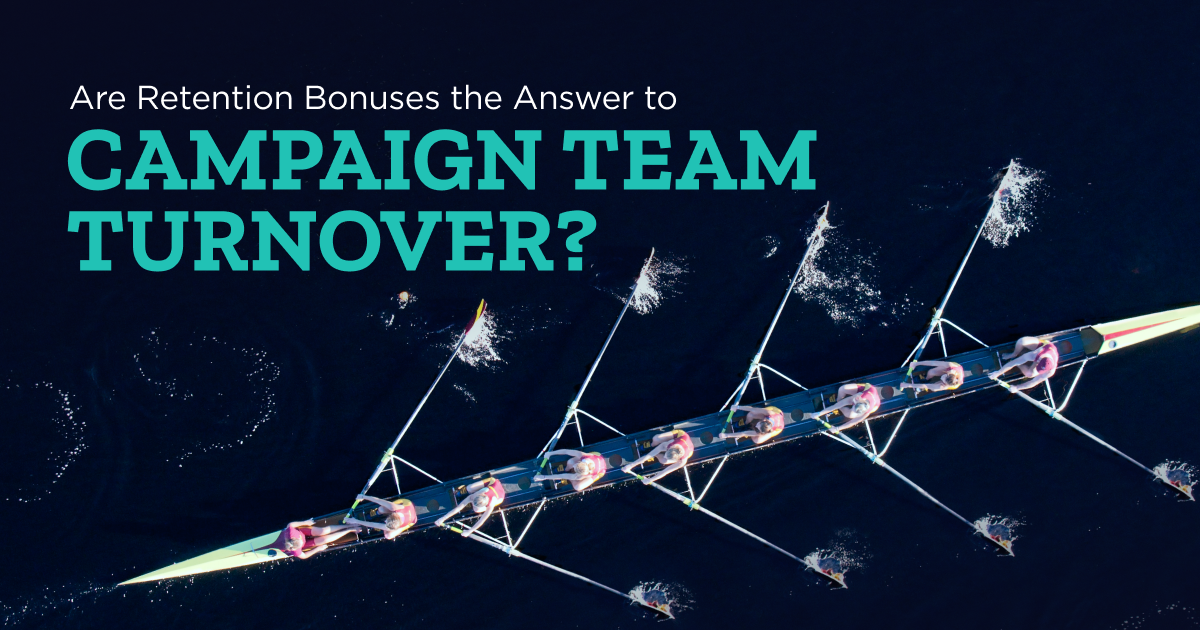A Million-Dollar Question
Given today’s competitive workforce environment, and the essential role that development teams play in fundraising campaigns, more organizations are asking, “How can we retain our staff during a campaign?”
It’s a million-dollar question, quite literally. A campaign’s success hinges on key employees—including CEOs, development directors, campaign coordinators, stewardship officers, database managers, and the program staff who deliver on the campaign’s promises. When a Tennessee nonprofit lost its executive director, for example, it took two years of relationship (re)building to secure commitments from its largest funders. Many organizations simply cannot afford such delays.
Increasingly, nonprofits are offering retention bonuses to encourage staff to stay. Typically paid along campaign milestones with the largest share at conclusion, these financial incentives show real promise in helping organizations build lasting teams.
Unlike a raise, which changes an organization’s long-term budget, a bonus allows for financial flexibility in the future. This financial incentive can be a tipping point for employees considering other opportunities. Take the case of Harvard Law School’s recent campaign: the school offered retention bonuses ranging from 5% to 17.5% of salaries to its fundraising staff. The result? Only one out of 22 senior fundraisers resigned before the campaign ended.
Question When Considering Retention Bonuses
No two retention programs are exactly alike. Beyond legal and ethical principles (e.g., bonuses should not be based on a percentage of dollars raised), there is ample flexibility in how an organization might structure its retention bonuses. The following are key questions to guide this process:
- What factors determine who is eligible for a retention bonus?
In terms of eligibility, roles essential for campaign success should be considered. Some organizations may define this broadly to include their entire fundraising team, program leaders, and other employees. Other nonprofits may focus on individuals who directly fundraise. When evaluating whether to reward a bonus, organizations may consider team performance (“Did we meet our goals?”) as well as individual performance (“Did this person earn positive performance reviews?” or “Did they make meaningful contributions to the campaign’s success?”). - How much will be offered?
The retention bonus must be a meaningful amount to work. Most organizations land on a number between 15% and 20% of an individual’s base salary, although the Harvard case demonstrates that lower percentages may also be effective. - How will payment(s) be structured?
Some organizations offer one lump-sum bonus at the end of a campaign. Others divide the bonus into installments and align payments with campaign milestones. Keep in mind that if the bonus is paid in parts, this could dilute its employee-retaining influence—unless the final installment is significantly larger than the others. - What will happen to bonuses if the campaign timeline is extended, or the goal is raised?
Goals and milestones can, and should, change as the campaign evolves. To remain flexible to this possibility, many nonprofits adopt a clause stating that bonuses are at the final discretion of the board. This allows the board to extend or stretch the campaign, as needed, and reflect any increased expectations within the final bonuses. - What conditions should be placed on retention bonuses?
At minimum, organizations should require that employees maintain positive performance reviews and be in good standing when the campaign concludes. Some organizations also stipulate that an individual must remain on staff for a defined period beyond the campaign, such as 3 or 6 months.
Alternative and Additional Incentives
Whatever retention strategies an organization adopts, the incentives should align with the culture and characteristics of that institution. Lump-sum bonuses are just one of the ways nonprofits can work to retain employees. Following the departure of Dana Farber Cancer Institute’s vice president of development, for example, the leadership team preemptively gave raises to its top fundraisers. The goal was to stave off more resignations, and it worked. Other nonprofits offer a “longevity bonus” in recognition of employment milestones, such as 5 years of service. Still others choose to offer weeks- or even months-long sabbaticals—the reward of paid time off—in place of, or in addition to, financial incentives.
Final Thoughts
Campaigns have the potential to transform organizations and the lives of those they serve. They also require immense and sustained energy from their campaign teams. When people meet extraordinary demands with extraordinary efforts, they warrant extraordinary recognition in return.
The information provided in this article and on this site does not, and is not intended to, constitute legal and/or human resources advice; instead, all information, content, and materials available on this site are for general informational purposes only. Appropriate legal counsel should be consulted when developing any employee recruitment or retention program.





